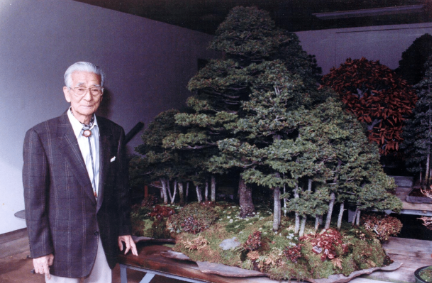The National Bonsai & Penjing Museum is home to impressive trees from collectors and masters around the world. Among that amalgam of donors is Dr. Yee-sun Wu, one of the most prominent penjing connoisseurs and stylists.
Dr. Wu was raised in a family that had practiced penjing for generations. He was born the eldest of 13 brothers and sisters in the Guangdong province of China. To support his family during the Great Depression, Dr. Wu started a bank in Hong Kong called Wing Lung Money Exchange – “Wing Lung” meaning “long-lasting harvest” or “good business.”
The organization has grown over the decades into a multi-story, highly respected business in central Hong Kong and Kowloon now known as Wing Lung Bank. But Dr. Wu retired from the bank business at the end of World War II after his health declined and he was forced to rest.
During this period, he devoted all of his time to studying traditional penjing, creating a new persona for himself as “Man Lung,” or “scholar-farmer.” In 1967 in Kowloon, Dr. Wu and a few friends created the Man Lung Garden to display trees and serve as a forum for discussion about penjing. The Chinese government eventually acquired the land in the 1970s to build a railway station, but the garden was established at the Hong Kong Baptist University again in 2000.
In 1968, Dr. Wu printed 10,000 copies of his book the Man Lung Garden Artistic Pot Plants, his international term for penjing, to discuss the features of the garden and the ideology, history and celebration of artistic pot plants.
He was one of six honorees at the Fuku-Bonsai Center International Honor Role in 1990.
Dr. Wu, who died in 2005, is survived by 13 children and almost 40 grandchildren and great grandchildren in Hong Kong.
Traditional styling
Former NBF President Felix Laughlin said servicemen returning from their stations in Japan after World War II brought bonsai knowledge back to the United States. But he said many people didn’t realize that the tradition of penjing, the Chinese word for bonsai, could be traced back hundreds of years to China.
Dr. Wu popularized traditional penjing, in the Lingnan style, throughout the Western world. Laughlin said Japanese bonsai artists often rely on wire to place branches in different positions, repeatedly replacing the wire as it cuts into the wood. Penjing artists like Dr. Wu tend to use the “clip and grow” technique, pruning again and again to determine branch placement, he said.
“You can tell bonsai have been heavily influenced by human care and training, while penjing are much wilder looking and free form,” Laughlin said.
Read more about the differences in the art form through our interview with Zhao Qingquan.
Dr. Wu’s trees
The penjing master curated a collection of more than 300 trees, which he donated to various institutions across the world. One can view Dr. Wu’s works in collections in Canada, Hong Kong, China and the United States.
Former U.S. National Arboretum Director Dr. John Creech was familiar with Dr. Wu’s excellent penjing collection. He sent Col. John Hinds, a retired military officer who was heavily involved in the bonsai community, to visit Dr. Wu in Hong Kong to inform him about the plans to curate a collection in the United States.
At first, Dr. Wu was impressed with the idea but thought his tropical trees would be better maintained on the West Coast, where the climate is more similar to Hong Kong and wouldn’t have cold winters like Washington, D.C. In 1983, Museum volunteer Janet Lanman wrote to Dr. Wu to renew the request that he display penjing at the Arboretum, assuring him that they could provide adequate winter protection for his trees.
In July 1986, the Arboretum received 31 penjing from Hong Kong – 24 from Dr. Wu and seven from his colleague Shu-ying Lui. Dr. Wu provided a generous monetary gift for NBF and the Arboretum to construct the Yee-sun Wu Chinese Pavilion and even sent over some workers from Hong Kong to help with the details of the project.
Although the Museum remains closed to protect staff and visitors during the spread of COVID-19, you can spot Dr. Wu’s trees online under our Chinese collection.























